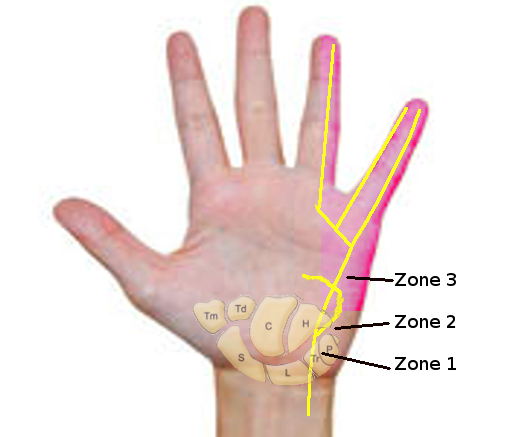[1]
Depukat P, Mizia E, Klosinski M, Dzikowska M, Klimek-Piotrowska W, Mazur M, Kuniewicz M, Bonczar T. Anatomy of Guyon's canal - a systematic review. Folia medica Cracoviensia. 2014:54(2):81-6
[PubMed PMID: 25648313]
Level 1 (high-level) evidence
[2]
Coraci D, Loreti C, Piccinini G, Doneddu PE, Biscotti S, Padua L. Ulnar neuropathy at wrist: entrapment at a very "congested" site. Neurological sciences : official journal of the Italian Neurological Society and of the Italian Society of Clinical Neurophysiology. 2018 Aug:39(8):1325-1331. doi: 10.1007/s10072-018-3446-7. Epub 2018 May 19
[PubMed PMID: 29779137]
[5]
Zarzecki MP, Popieluszko P, Zayachkowski A, Pękala PA, Henry BM, Tomaszewski KA. The surgical anatomy of the superficial and deep palmar arches: A Meta-analysis. Journal of plastic, reconstructive & aesthetic surgery : JPRAS. 2018 Nov:71(11):1577-1592. doi: 10.1016/j.bjps.2018.08.014. Epub 2018 Aug 24
[PubMed PMID: 30245020]
Level 1 (high-level) evidence
[6]
Al-Qattan MM, Alqahtani A, Al-Zahrani A. High trifurcation of the ulnar nerve with the volar sensory branch entering the hand superficial and radial to the Guyon's canal: A case report. International journal of surgery case reports. 2018:51():33-36. doi: 10.1016/j.ijscr.2018.08.006. Epub 2018 Aug 10
[PubMed PMID: 30138867]
Level 3 (low-level) evidence
[8]
Dodds GA 3rd, Hale D, Jackson WT. Incidence of anatomic variants in Guyon's canal. The Journal of hand surgery. 1990 Mar:15(2):352-5
[PubMed PMID: 2324469]
[9]
Hoogvliet P, Coert JH, Fridén J, Huisstede BM, European HANDGUIDE group. How to treat Guyon's canal syndrome? Results from the European HANDGUIDE study: a multidisciplinary treatment guideline. British journal of sports medicine. 2013 Nov:47(17):1063-70. doi: 10.1136/bjsports-2013-092280. Epub 2013 Jul 31
[PubMed PMID: 23902776]
[10]
Athlani L, De Almeida YK, Maschino H, Dap F, Dautel G. [Hypothenar hammer syndrome: A recurrent case report after surgery]. Journal de medecine vasculaire. 2018 Sep:43(5):320-324. doi: 10.1016/j.jdmv.2018.06.002. Epub 2018 Aug 24
[PubMed PMID: 30217347]
Level 3 (low-level) evidence
[11]
Moghtaderi A, Ghafarpoor M. The dilemma of ulnar nerve entrapment at wrist in carpal tunnel syndrome. Clinical neurology and neurosurgery. 2009 Feb:111(2):151-5. doi: 10.1016/j.clineuro.2008.09.012. Epub 2008 Dec 11
[PubMed PMID: 19084328]

